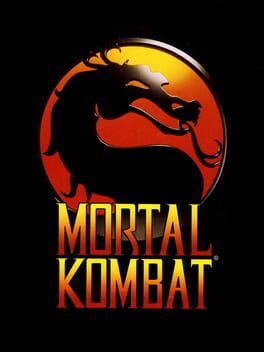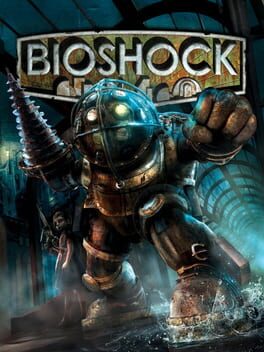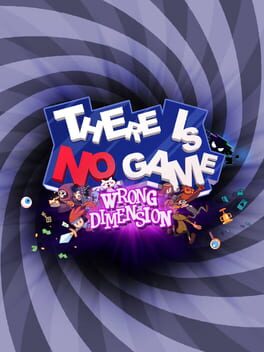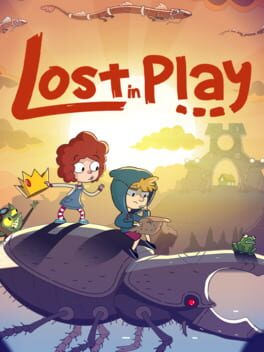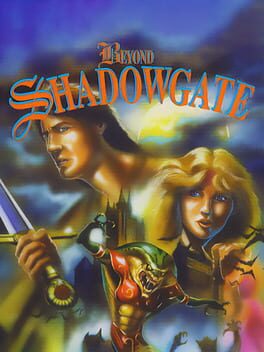BinaryMessiah
I've been gaming since I was 3 years old. My first video game was Mortal Kombat for the Sega Genesis back in 1993 and my first gaming console was a Sega Genesis. I've been a gamer ever since! I'm currently a nurse and have two wonderful boys who are also gamers! Gotta keep the cycle going! I write reviews on my own gaming site which has been active since 2009. I do it for fun and get out my thoughts.
Badges

Well Written
Gained 10+ likes on a single review

Treasured
Gained 750+ total review likes

GOTY '23
Participated in the 2023 Game of the Year Event

Donor
Liked 50+ reviews / lists

Gone Gold
Received 5+ likes on a review while featured on the front page

Trend Setter
Gained 50+ followers

Best Friends
Become mutual friends with at least 3 others

2 Years of Service
Being part of the Backloggd community for 2 years

Organized
Created a list folder with 5+ lists

GOTY '22
Participated in the 2022 Game of the Year Event

Adored
Gained 300+ total review likes

Popular
Gained 15+ followers

Loved
Gained 100+ total review likes

Listed
Created 10+ public lists

Noticed
Gained 3+ followers

Liked
Gained 10+ total review likes

Busy Day
Journaled 5+ games in a single day

Elite Gamer
Played 500+ games

Gamer
Played 250+ games

N00b
Played 100+ games
Favorite Games
974
Total Games Played
015
Played in 2024
000
Games Backloggd
Recently Played See More
Recently Reviewed See More
That has all changed. Square Enix did a great job bringing the game up to par with modern audiences and video game standards. Not only is the story well told and easy to follow, but it's still complex and full of interesting and lovable characters. While this game is only what the first disc from the original offered, there are 30+ hours of content here to explore. While the game isn't perfect, there is more to love than to hate, and I was surprised at how great this game was. I didn't want to put it down. From the well-done English voice-acting (which was a shocker) to the well-paced and fast-moving story, the game never got stale (at least during the story moments).
The basic structure of this game is very linear. This is a dated design choice that transferred over, but some think this game has been in development since the tech demo for the PS3 reveal was shown in 2006. If that were the case, then this linear design would have been considered mostly modern at the time. There are large towns to explore, but these still have linear paths, and the story mode is a single path you follow, and there's no way to branch off. This is both fine for a scripted story but also feels cramped in some aspects. Despite how large Midgar feels, with sweeping vistas and massive backdrops, you can explore very little of it. There's a large sense of scale, but what you can explore just feels so claustrophobic in comparison. Many thought this would be an open-world game, but to follow the story the way Square Enix's wants, that wouldn't be possible, and I can see why they chose this path.
Exploring the game (and even the menu system) is similar to most modern Final Fantasy games. You run around towards a goal, fight bosses, run into enemies, do some mini-games, complete side quests, and try to get the best accessories, armor, and weapons in the game. This is all slowly introduced to you, but let's start with the combat, as that's the bulk of the game. Combat is not turn-based, but you can pause the action to give commands. The controls are intuitively designed to allow this to be done with minimal effort. You have regular attacks, a special attack, a block, and a dodge button. When enemies have red exclamations over their heads with the attack name, you know it can't be blocked but must be dodged. Cloud's alternate special attack is actually a stance called Punisher Mode, and while you block him, he will auto-parry incoming attacks. This comes in handy all the time.
You can issue commands, such as using ababilities. These are obtained by changing weapons. Materia can be equipped to give you commands that use MP. Things like magic, offense, defense, and even passive Materia can be slotted. Different weapons and equipment determine your slot count. It's important that you learn this system well and balance your team. You can only have three active party members at a time, but you never change your party. It's all based on the story. You will go through multiple chapters with a missing party member, but you can still upgrade and equip them all the time, even when they aren't with you. Powering up weapons is also a must. Each weapon has strengths and weaknesses. Some focus on sheer power, some on magic, and some on defensive skills. You acquire SP through combat and can use it across all weapons. Each weapon gets the same pool of SP separately. If you have 90 SP, you can use that separately on each weapon, which is really nice. As you level up, you unlock new SP pools.
Combat is fast-paced, fun, and exciting. Each character can be controlled by the player in combat only. During exploration, you're mostly stuck as Cloud or another character, as the story deems fit. Cloud is an all-rounder; Aerith mostly focuses on magic and distance combat; Tifa is a fast-paced melee fighter; and Barret uses a mid- to long-range gun, which is great for aerial enemies. He also has a ton of HP and defensive points. You can issue commands to other characters with the triggers that pause combat. You all have two AP gauges that fill up slowly over time or quicker as you do damage. These are needed to even use items in combat. These guides are the center of your strategy because, without them, you will die. You have limit breaks, which really can only be filled during longer battles (mostly bosses) and summons that deal massive damage, but the battle needs to be long enough to fill these guages.
Summons are mostly acquired optically through the VR training. You only get two during the story mode automatically. These are the keys to strategizing battles and winning as quickly as possible. I found the combat rarely frustrating. Only during long boss battles with multiple phases did I find it annoying that these cut-scenes were not skippable. You need to watch them all over again if you die. This didn't become an issue until towards the end of the game. You can run away from battle by running away and fleeing, and thankfully enemies regenerate until you leave the entire area and come back. The boss battles are all unique and imaginative, and no one is the same. The smaller enemies are also unique and different, and they require you to learn their attacks and know what is weak against what type of attack. There is a lot more strategy in the combat system than a simple hack-and-slash setup.
While combat is the bulk of the game, you will spend a lot of time outside of combat. There are a few simple puzzles inside some dungeons, but the hub areas or towns you explore allow you to rest, buy items, materia, armor, and weapons, and that's about it. The side quests and mini-games are some of the weakest parts of this game. While not every side- question is bad, Some offer challenging boss fights and good rewards; some just don't offer much story-wise. I completed almost all of them anyway for more XP, SP, and the items they offered, but fetch quests are just not fun here. Not to mention, the mini-games are incredibly tedious and boring and not well thought out. There's an okay darts mini-game. Beating the highest score and achievement. But there's a box-breaking mini-game that requires you to run around breaking different-sized boxes. This was incredibly tedious and not fun. There are combat VR simulators that net you material. Most of which you can acquire elsewhere. Then there's the optional summons, which can be incredibly difficult to acquire early on as you need to beat them, and you need three party members to even have a fair chance. There's also a pretty stupid dancing rhythm mini-game. It's just, overall, a bit lame.
Some other annoying niggles come from dated design decisions, like treating the player like they're stupid. For decades, games would have you flip a switch, cut the camera away, show you that a gate in front of you opened, and then give you control. I'm pretty sure most people can figure out that the switch opened the only gate on the only path you can go down. I also got annoyed by how animations would have to line up to whatever script they were tied to, do the animation, re-align, change animations, flip the switch, then go back. It just slowed things down a lot.
Outside of the mostly optional and passable annoyances, the visuals are fantastic. Character models look amazing, the pre-rendered cutscenes are some of the best in the industry, and the story and overall character designs are some of the best you will ever come across. The story is deep and full of political intrigue, and I want to know more about this world, the characters, and see things move on. It's sad that Square Enix takes so long to make sequels, but what are we going to do? With the fantastic combat system that adds just enough strategy and depth to the large swath of enemies, bosses, environments, and perfect pacing, FF7 Remake is fantastic. The additional Intermission DLC is also wonderful, and playing as Yuffie is a blast. The short, 4-hour story DLC still has more of the same lame mini-games and annoyances as the main game, but the story is just so well done. There's nothing quite like it out there.
You have to really think outside the box with this game, as you can take down parts of the UI and completely break the smaller games inside to progress. You will end up with a classic adventure title and a JRPG that makes fun of Zelda tropes. The game also pokes fun at other games and mechanics, such as microtransactions and free-to-play mechanics. I don't want to spoil the Easter eggs, but the game has a great sense of humor, and anyone who has watched a few behind-the-scenes videos on how games are made will appreciate this game and the message it's getting across.
Every area is new and different, and no two puzzles are the same. Some areas have multiple screens, and you can manipulate them in interesting ways, such as unscrewing the computer monitor you're playing the game on and getting the back of the scene through the back panel. You have to also be okay with dragging the objects onto everything and trying combinations. Some things may not look obvious, but they make sense once you get the object or discover its use. Things like a mouse cursor popping a balloon, a metal letter T being used as a screwdriver, and the sign to a game title being used as a bridge. Almost every puzzle can be figured out with a bit of thinking, but a few were so obscure that I had to use all the hints available to me. When you press the hints button, it will show locks over the object that has hints. This can also be useful just to figure out what objects can be interacted with or what your focus should be without even using a single hint.
There are cutscenes in the game that can't be interacted with, and this is shown with filmstrips going up the sides of the screen. Because this is a "joke" game and you can break actual games inside, you need other cues as to what's a joke and what is not. Sometimes I didn't know what was a joke and wound up restarting the game, but you also need to trust the game. There isn't much else in terms of gameplay, but there doesn't need to be. This is a very clever idea for a game that I have never seen before. The story is interesting, the characters are likeable, and it's just an overall fun time and something really unique. The visuals are charming and switch up all the time, which makes you think outside the box.
You play as a brother and sister, Gal and Toto, who wake up on a bright summer day and decide to get lost in their own imaginations. The first few chapters have you going from their reality to actual reality to give you this idea of what's going on. The game is full of a lot of puzzles and figuring out what items go where. This can be both fun and frustrating at the same time. I wasn't a fan of most of the puzzles, but the screen increases in numbers as you look for objects and figure out what needs to go where.
The first screen is a perfect way to introduce this. It's just a single screen, and you learn to click on objects that are standing out. The characters will interact with it or talk to the person. A bubble will pop up with the item the character wants, or your player character will pop a bubble up explaining in one single picture what they need to do. There is a generous hint system that shows a single picture of what to do next or helps you get started with a puzzle. I love this, and it doesn't punish the player at all; however, some of the hints were not helpful.
As you progress through the game, you get to chapters with many screens and many things to interact with. Once you find your first object, you can usually build momentum and realize who needs what and where. The puzzles are the worst part of the game. Extremely hard slider puzzles; some games are won purely on chance, which is frustrating. Sometimes rules aren't explained well enough. A particular puzzle with lasers and having to slide animals around to deflect gets very frustrating as it's a sliding puzzle. The worst one in the game is the final puzzle, in which you have to trap a jumping frog on a grid. It's done by pure chance, and no walkthrough will help you. There are also some puzzles with symbols, and it seems impossible to figure out what they represent or how to interpret them.
The puzzles aren't very common, but they do hamper some of the experience. I really loved seeing all of the detail poured into this game's animation. It feels like a high-quality cartoon. Every interaction is a new animation. One particular point where this stood out was Gal or Toto picking up the same type of object numerous times. Instead of the same pick-up animation, each one was unique. They didn't have to do that. It makes the entire game feel alive and soulful. The story itself isn't anything complex or deep, and there's no voice acting. Characters speak in a simple fashion, which adds to the charm of the game. The visuals are bright and colorful, and every screen and moment feels special. They don't make many games like this.
Outside of the puzzle issues, there was just a small annoyance with touch controls on mobile. Tapping the screen can sometimes cause you to interact with the same object or character, but it was nothing serious. Every area felt unique and different, and I couldn't put the game down until the end. You can probably finish this in 2-3 hours, but it's so much fun and constantly feels fresh and new. Lost in Play is a rare adventure game that I actually might remember and talk about later with people. This game proves that every little detail can make a difference.


